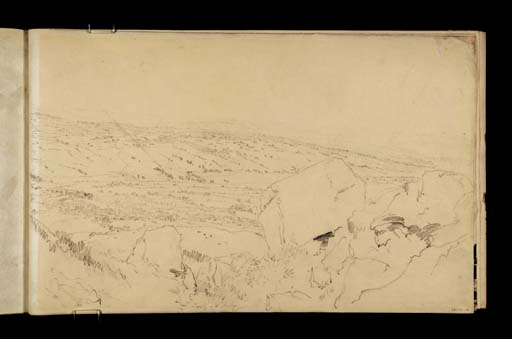Joseph Mallord William Turner Farnley Hall and Otley from the West Chevin c.1816
Image 1 of 2
Joseph Mallord William Turner,
Farnley Hall and Otley from the West Chevin
c.1816
Joseph Mallord William Turner 1775–1851
Folio 40 Recto:
Farnley Hall and Otley from the West Chevin c.1816
D09056
Turner Bequest CXXVIII 40
Turner Bequest CXXVIII 40
Pencil on white wove paper, 285 x 460 mm
Watermarked ‘J WHATMAN | 1801’
Inscribed by Turner in pencil ‘Fox G & Thistle’ bottom centre
Stamped in black ‘CXXVIII 40’ bottom right
Watermarked ‘J WHATMAN | 1801’
Inscribed by Turner in pencil ‘Fox G & Thistle’ bottom centre
Stamped in black ‘CXXVIII 40’ bottom right
Accepted by the nation as part of the Turner Bequest 1856
Exhibition history
1869
Second Loan Collection, various venues, see main catalogue entry, 1869–1931 (131, as ‘Landscape, Yorkshire’).
References
1909
A.J. Finberg, A Complete Inventory of the Drawings of the Turner Bequest, London 1909, vol.I, p.361, CXXVIII 40, as ‘Otley, from Caley Park...’.
1969
Graham Reynolds, Turner, London 1969, p.69 reproduced.
1991
Ian Warrell, ‘R.N. Wornum and the First Three Loan Collections’, Turner Studies, vol.11, no.1, Summer 1991, p.44.
1996
Gillian Forrester, Turner’s ‘Drawing Book’: The Liber Studiorum, exhibition catalogue, Tate Gallery, London 1996, p.146 , no.82, note 7.
Finberg was slightly mistaken in his identification of this view as Otley from Caley Park. Whereas Caley Park is the continuation of Otley Chevin to the east, this sketch is actually taken from the mid-slopes of the Great Dib to the south and very slightly west of Otley Church. The church tower is visible in the mid-distance left, and Otley Bridge beyond, further left. The lane to Walter Fawkes’s seat Farnley Hall can be traced right from the bridge, rising left and right to the house in the centre distance. Almscliff Crag closes the composition on the horizon to the right. Today the area is much changed by tree growth and is difficult of access and Turner’s foreground rocks are not at all obvious. However, the angles of view leave no doubt as to the general viewpoint, which, it is perhaps worth noting, appears to be at an elevation of about 450 feet, well below the now-popular summit viewpoint around 925 feet.
Turner sketched exactly the same view, with the same foreground rocks, in the Hastings sketchbook (Tate D10406; Turner Bequest CXXXIX 40a). It is perhaps curious that he should have repeated the subject so exactly. The sketch in the Hastings sketchbook is one of a series that explores the general composition and foreground arrangement leading to a ‘colour-beginning’ (Tate D17177; Turner Bequest CXCVI M) and then a finished watercolour of Farnley Hall from above Otley (Rijksmuseum, Amsterdam), painted for Fawkes about 1816–18.1 It might be, however, that the present sketch is still the culmination of Turner’s exploration of the site, since its large format allows by far the most intensive treatment of the detail.
Gillian Forrester draws attention to sketches on the verso (Tate D40043) of a drawing of The Felucca (Tate D08175; Turner Bequest CXVIII U), and on the verso of a watercolour of Huntsmen in a Wood (British Museum, London),2 suggesting these perhaps show the same site. The former includes figures standing on top of crags, and the latter two sketches of crags and a ‘Quarry’. Both might well show localities in the neighbourhood of Farnley Hall, but neither is specifically the same site as the present sketch.
A copy of Finberg’s Inventory now in Tate’s Library contains handwritten annotations by the author noting that this drawing was damaged when the Tate Gallery was flooded in 1928.3 The centre of the sheet a little darkened, presumably as a result of exposure during the touring Second Loan Exhibition.4 There is a scuff mark running diagonally across the sheet
Verso:
Blank
David Hill
October 2009
How to cite
David Hill, ‘Farnley Hall and Otley from the West Chevin c.1816 by Joseph Mallord William Turner’, catalogue entry, October 2009, in David Blayney Brown (ed.), J.M.W. Turner: Sketchbooks, Drawings and Watercolours, Tate Research Publication, September 2014, https://www


